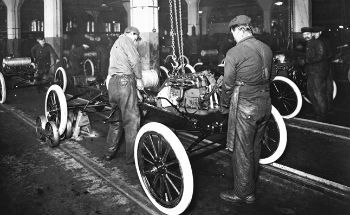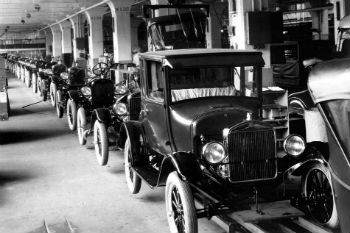The Fordism is a mass production mode based on the production line designed by Henry Ford.
It was fundamental to the rationalization of the production process and the low cost manufacturing and capital accumulation.
Features
The Fordism was named in honor of its creator, Henry Ford. It installed the first semi-automated car production line in 1914.
This would become the management model of the Second Industrial Revolution and would last until the mid-1980s.
This mass production system, called the production line, consisted of semi-automatic assembly lines, made possible by heavy investments for the development of machinery and industrial facilities.
Two workers put the engine in a Ford T
In turn, Fordism made these products accessible to the mass consumer market, as it reduced the cost of production and cheapened the articles produced.
Note that the decrease in prices has been accompanied by the fall in the quality of manufactured products.
As a result, this model has spread around the world and consolidated itself in the postwar period, guaranteeing the golden years of prosperity for developed countries.
In addition, it has led to unprecedented economic growth and allowed the creation of social welfare societies in these countries. The production standard reached other production lines, mainly in the steel and textile sectors.
Henry Ford and Fordism
Henry Ford (1863-1947) was the creator of the Ford automobile production system at his factory, the “Ford Motor Company”.
It was from her that he established his doctrine, following 3 basic principles:
- Intensification: allows to streamline production time
- Economy: aims to keep production balanced with its stocks;
- Productivity: aims to make the most of the workforce of each worker.
Fordism and Taylorism
Henry Ford perfected Frederick Taylor’s Taylorism on the concept of assembly line.
While Taylorism sought to increase worker productivity by rationalizing movements and controlling production. Its creator, Taylor, was not concerned with technology issues, supply of inputs or the arrival of the product on the market.
On the other hand, Ford included verticalization, which controlled everything from the sources of raw materials to the production of parts and distribution of its vehicles. These would be the main differences between the two methods.
Fordism Innovations
The main innovations of Fordism are technical and organizational in nature.
Among them, we highlight the implementation of conveyor belts, which take part of the product to be manufactured to employees. They began to perform extremely exhausting and repetitive jobs.
Ford T Production Line in the 1920s in the United States
Due to the functional specialization to which they were subjected and by which they were limited, these workers could not qualify because they did not know the other stages of production.
In addition to the lack of professional qualification, the workers suffered from the hard workday and the little labor rights.
Nevertheless, the improvement in the living standard of the industrial working class was remarkable and allowed the establishment of these workers as consumers.
Decline of Fordism
Due to the rigidity of the production method, Fordism has been in decline since the 1970s.
At this time came the successive oil crises and the entry of the Japanese into the auto market.
The Japanese introduce toyotism, that is, the Toyota production system, which emphasizes the use of electronics and robotics.
Fordism and Toyotism
In the 70’s, the Fordist production model was replaced by toyotismo. This had been developed by the Japanese factory Toyota.
In Toyotismo, employees are specialized, but are responsible for the quality of the final product.
Unlike Fordism, there is no stock of the product. Manufacturing occurs only when there is demand and there is no production surplus. This saves on storage and purchase of raw materials.
Thus, as early as the 1970s / 1980s, Ford Motor Company lost the rank of 1st automaker to General Motors. It is later replaced by Toyota in 2007, when the Japanese automaker becomes the largest in the world.



